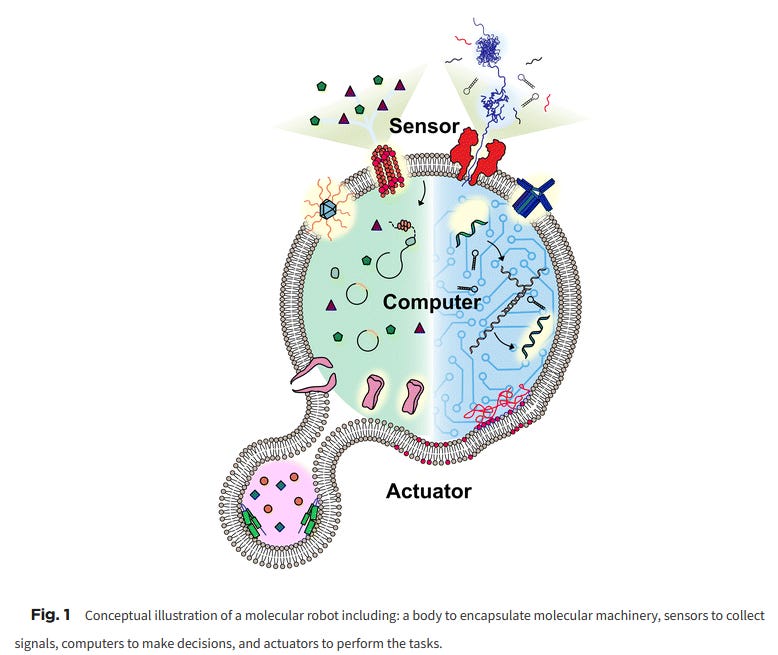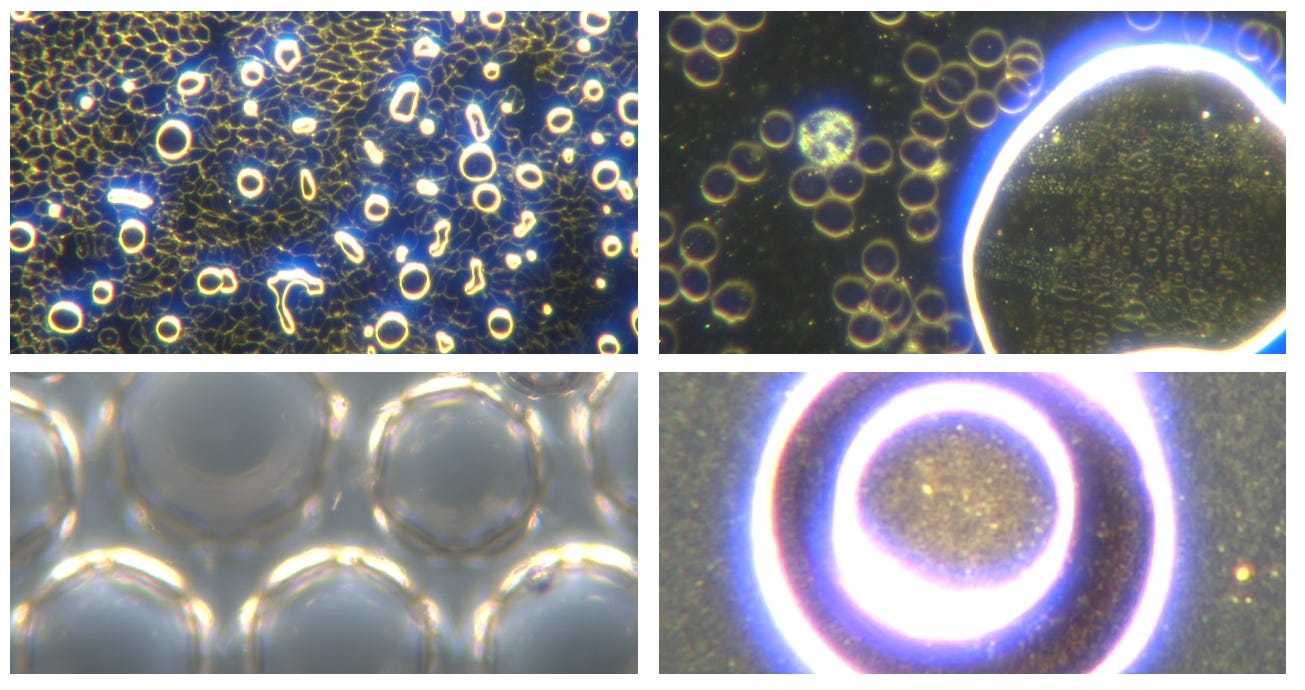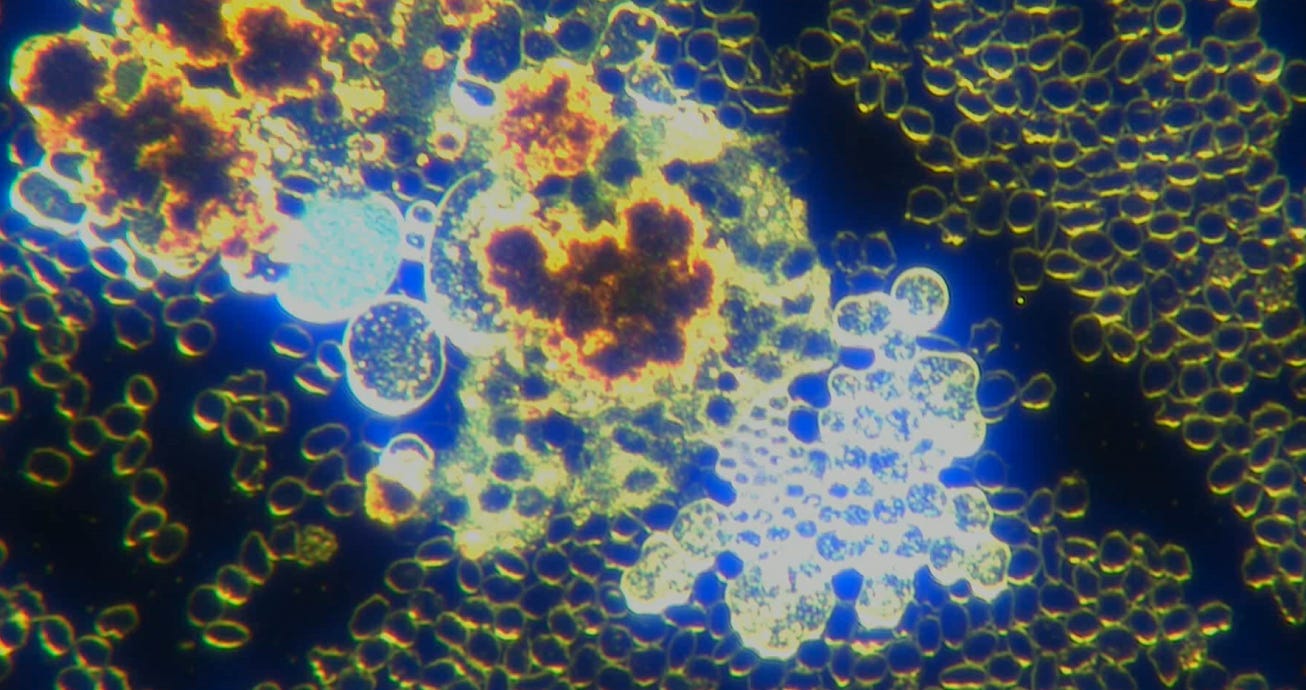"Lipid Vesicle-Based Molecular Robots" - Article Confirms What We Are Seeing In The COVID19 Vials And In Human Blood
I had several meetings with biologist Dr. Ruth Espuny and her research team in the past days and she alerted me to this article that very well explains the lipid vesicles that I call construction sites. Here I am posting relevant sections of the article and sharing confirmatory images from my own and others research.
Lipid vesicle-based molecular robots
A molecular robot, which is a system comprised of one or more molecular machines and computers, can execute sophisticated tasks in many fields that span from nanomedicine to green nanotechnology. The core parts of molecular robots are fairly consistent from system to system and always include (i) a body to encapsulate molecular machines, (ii) sensors to capture signals, (iii) computers to make decisions, and (iv) actuators to perform tasks. This review aims to provide an overview of approaches and considerations to develop molecular robots. We first introduce the basic technologies required for constructing the core parts of molecular robots, describe the recent progress towards achieving higher functionality, and subsequently discuss the current challenges and outlook. We also highlight the applications of molecular robots in sensing biomarkers, signal communications with living cells, and conversion of energy. Although molecular robots are still in their infancy, they will unquestionably initiate massive change in biomedical and environmental technology in the not too distant future.
This historical perspective answers a question I am often asked regarding to how this self assembly nanotechnology could be so far advanced. As you can read here, its because the scientists have been working on it for the last 40 years.
During the past 40 years, this revolution has led to a new generation of machines with smaller sizes, pushing the boundaries of applications. In the field of organic chemistry, a breakthrough molecular catenane with two interlocked rings was reported by Jean-Pierre Sauvage in the early 1980s,1 subsequently inspiring other scientists to develop molecular-scale machines with complicated functions such as rotaxanes,2 motors,3 and nanocars.4 In 2016, three pioneers of molecular machines were awarded the Nobel Prize in Chemistry, reflecting the recognition of the broad impact of molecular machines.
Here they explain that these robots mimick the processes of nature.
The concept of molecular machines has motivated research activity in a novel field called “molecular robots”.5 According to the Cambridge dictionary, a robot is “a machine controlled by a computer that is used to perform jobs automatically”. By this definition, a molecular robot is a system composed of molecular-scale machines and computers that are used to execute tasks automatically. A living cell could be considered as one such miraculous robot produced by nature. With DNA serving as computers to provide solutions and proteins working as machines to perform specific functions, a living cell performs sophisticated tasks independent of human control. Taking inspiration from living cells, the ultimate goal of the field of molecular robots is to artificially construct an automated system capable of solving problems at the molecular level using molecular machines and computers
The vesicular membrane was initially hydrogel, then lipids were used.
Image: Vesicles in COVID19 unvaccinated blood left upper Magnification 200x, right upper 400x. Left lower vesicles in Pfizer BioNTech COVID19 injection without slide cover Magnification 2000x. Right lower with slide clover shows double wall and microrobots inside. Magnification 2000x. AM Medical
A molecular robot always includes some or all of the following: a body, sensors, computers, and actuators (Fig. 1). Pioneers in the field have applied hydrogels as the body of molecular robots,5 however, the lack of a barrier between the embeddings and environment can lead to undesired leakage. Lipid vesicles, which are comprised of lipid membranes separating an inner lumen from the outer solution, provides an alternative that could fully meet this problem. The size of the lipid vesicles can be tailored from nano- to micro-meter in diameter. For molecular robots, the micro-sized vesicles, so-called giant unilamellar vesicles (GUVs), are more desirable due to the demand for sufficient internal volume to house the sensors, computers, and actuators.8,9 Molecular robots require sensors in order to detect signals in the environment. This can be accomplished by ion channels or nanopores, which punch holes in lipid membranes.
Image: Brightfield microscopy of Moderna COVID19 injection. Medical Technologist, Lot 042H22A, Courtesy of Dr Rusth Espuny
You can see these nanopores in the above images. For those who claim we cannot see to the nanoscale, let me remind you that this technology self assembles and that we can see the microscale very well. The large comes from the small and I have shown how self repication of these spherical robots work in emblamed blood, please recall this microscopy: ( I showed the videos in this interview
You can see the video footage in this interview on SGT report:
RED ALERT: IT'S IN OUR BLOOD! -- Dr. Ana Mihalcea
Image: Embalmed blood received from Embalmer Richard Hirschman of a deceased individual shows self replicating vesicles containing microrobots. Magnification 400x AM Medical
Nanopores can act as a signal filter, selectively transporting molecular signals based on their size or charge. Once the signals are transported, they can be processed and translated by molecular computing machinery. DNA computing, pioneered by L. Adleman in 1994, has evolved in recent decades into computers applicable in molecular robots, with the benefit of their capability to perform multiple parallel computations. An alternative choice for the computing machinery is cell-free protein synthesis (CFPS), enabling the output of proteins in vitro in response to the input of DNA.Actuators for molecular robots, which include DNA nanostructures, peptides, and proteins, convert signals to achieve physical movements like deformation or propulsion.
The mechanism of propulsion and engines are explained.
Although constant progress has been made on the underlying technology, studies into prototyping molecular robots do not have a long history. In 2014, Nishimura et al.incorporated CFPS into GUVs, and then, in the presence of amino acids, GFP synthesis was performed as an output. In 2017, Sato et al. developed GUVs equipped with actuators containing DNA clutches and microtubule motors. Once light irradiation was applied, the clutch was engaged and the shape of GUVs underwent sequential changes. These pioneering studies provide a clear path towards molecular robots with increasingly complex functions.
It should be noted that molecular robots sometimes share related technologies with the field of artificial cells. The goal of constructing artificial cells is to mimic the function of living cells, while molecular robots place great value on developing engineering applications that could help humans to perform tasks in micro or nano dimensions. There is therefore a drive to engineer molecular robots with functions exceeding those of living cells
Further building blocks are explained. Note that lipid membranes, polymers, hydrogels and organic material like DNA are used. Is this why DNA was found in the vials combined with nanotechnology building blocks?
Molecular robots typically require encapsulation within a compartment, which acts as a boundary, separating the interior from the exterior environment. Various types of compartments have been employed to date, including lipid membranes,hydrogels, block co-polymers, DNA droplets,and coacervates, each offering distinct advantages and limitations. Some researchers have explored the formation of hybrid chassis by combining different compartment types, leveraging the advantages associated with each constituent part. For instance, coacervate or DNA/hydrogel systems interfaced with lipid membranes can be combined to enhance functionality.
Among these compartment types, lipid vesicles are the most commonly used for several reasons. Firstly, they are biomimetic, closely resembling biological membranes from a chemical and morphological perspective. This characteristic enables facile incorporation of membrane-bound molecular machinery, including membrane proteins, nanopores, and receptors, thereby imparting specific functionalities into the membranes. For example, the controlled flux of cargo molecules in response to stimuli, which can be used to mediate responses in living cells.
Please note that these vesicles can self assemble or disassmeble into tissue like structures - depending on external stimuli. This is consistent with what we have observed in COVID19 vials regarding the self assembly nanotechnology and in the blood. Please recall Dr David Nixons excellent videos on assembly and disassembly of microchips - you can see the process discussed here by Dr. Nixon, Dr. Shimon Yanowitz, Engineer Matt Taylor and myself. Nanobots, Construction process of Microchips in C19 injectables, new insights on Shedding
Furthermore, lipid vesicles are chemically inert and highly efficient at compartmentalizing large charged molecules from the surrounding environment, creating a chemically distinct internal environment. This feature enables researchers to exploit the diversity of lipid building blocks, both synthetic and biological, to create functional membranes with diverse behaviors. Examples include membranes capable of self-assembling into tissue-like structures, membranes that can disassemble and reassemble in response to physicochemical cues to reshuffle material between them, and membranes that release cargo triggered by light, temperature fluctuations, magnetic fields, or biomarkers. Such versatility opens up exciting possibilities for molecular robotics and targeted drug delivery systems, among other applications.
Images: vesicles self assemble filaments 200x, vesicles filled with microbots 400x, vesicle building a filament tail 100x. AM Medical
Vesicles can be classified primarily based on their size and lamellarity. GUVs have a diameter of approximately 2 μm and above (making them cell-sized vesicles), comprising a single lipid membrane (as opposed to multi-layered onion-like structures known as multilamellar vesicles). Other types of vesicles include small and large unilamellar vesicles, which fall into the sub-micron size range, as well as multi-vesicular vesicles (multisomes). Additionally, there have been intriguing examples of hybrid structures, where vesicles of different types are assembled into more architecturally complex arrangements, such as nested or layered geometries. A schematic of the different architectures it is now possible to generate microfluidic techniques and principles in biomembrane engineering is shown in Fig 2
Image: COVID19 unvaccinated blood of different individuals exposed to shedding. Left upper tissue like 200x, left lower bilayer COVID19 Pfizer BioNTech 2000x, lower middle nested 2000x, right nested and multicompartment 400x. COVID19 unvaccinated blood. AM Medical
Sensors of molecular robots
In living cells, membrane receptors, transporters, and ion channels work as sensors to help cells respond to chemical and physical stimuli. Such functionalities have also been exploited to implement sensing capabilities in molecular robots. In particular, nanopores forming stable nanoscale openings across lipid membranes have been shown to mediate transport of large molecules, enabling their detection by the molecular robots.7 The opening and closing of nanopores (gating) can be regulated by environmental stimuli (e.g., pH, light, temperature, osmotic pressure), further enhancing the sensing capabilities of the molecular robots. Various materials have been utilized to assemble nanopores including proteins,60 peptides,61 DNA,11and synthetic materials.62 In the current section, we will mainly focus on the characteristics, differences, and recent progress of nanopore assembly using different building materials, and we will also describe some unique approaches that introduce membrane receptors to GUVs.
Many different transport channels that allow the throughput of information exist within these vesicles, and light is one of the triggers. This implies that the molecular robotic computer is information gathering and processing when we see the light emission.
Responsivity to external stimuli is another essential function for synthetic channels and would provide the ability for remote-control in molecular robots. Light is one of the most widely used stimuli due to having high biocompatibility and ease of spatio-temporal control. So far, light-responsive synthetic channels which are irreversibly and reversibly photo-controlled have been developed, and recent studies focus predominantly on reversible photo-control.
I have been discussing how the self assembly process of the technology is guided by light emitting microrobots/ Quantum Dot like structures. Here you can see many different colored light emissions.
Image: COVID19 unvaccinated blood of different individuals exposed to shedding. Left microrobot swarm 400x, left microrobot emitting blue light 2000x,
Computers of molecular robots
Molecular robots go hand-in-hand with biological computers, where biological computers take available inputs and translate them into appropriate outputs. Thanks to advances in synthetic chemistry and biology, biologically derived molecules such as DNA and proteins have become readily available, leading to the development of biological computers such as DNA computing systems and CFPS
Here it explains that this is an actual computer that is swimming in our bodies - that can compute calculations at remarkable speeds.
DNA computing
Due to the remarkable programmability of DNA molecular behavior based on sequence-dependent hybridization, enzymatic reactions, and strand displacement reactions, DNA computing has emerged as a promising candidate for the computational machinery of molecular robots. The genesis of DNA computing can be traced back to Adleman's pioneering work: massively parallel computation using artificially sequence-designed DNA. He encoded the nodes and paths in the Hamiltonian path problem onto different ssDNA to execute hybridization-based parallel exploration of the correct Hamiltonian path. By exploiting DNA self-assembly, this methodology allowed large-scale computations to be performed with low energy consumption. Besides the subsequent implementation of mathematical computations (satisfiability problem, maximal clique problem,etc.), Benenson et al. constructed DNA-based finite automata with two states using programmed DNA sticky/blunt ends, restriction nuclease, and ligase (Fig. 8(a)). The two states in the automata run at a rate of 109 transitions per second in an input-responsive manner, being the prototype of the smallest biocomputer as certified by Guinness World Records. Originating from the above single-information processing systems, the development of DNA computing has recently steered towards multiplex information processing.
DNA nanotechnology
DNA nanotechnology enables exquisite control over the structure of self-assembled macromolecular and nanoscale motifs. DNA nanodevices are however far from static and have been engineered to reconfigure, change shape, and move in response to a wide array of stimuli. From the ground-breaking examples of DNA tweezers and walkers, to the origami crank-sliders and joints demonstrated by the Castro group, to the bioinspired rotors built by the Dietz and Simmel groups, DNA nanomachines and nano-actuators have demonstrated an unparalleled ability to control different types of motion at the nanoscale. Furthermore, these nanodevices can be actuated through a variety of different stimuli, from strand displacement to the species and concentration of cations, to changes in pH, light exposure, and enzymatic action.
As discussed in the section on DNA nanopores, DNA nanostructures can be mechanically coupled to lipid membranes using lipophilic anchors, typically cholesterol or tocopherol. This coupling unlocks vast opportunities to engineer both the morphology and dynamic responses of GUV-based microrobots and artificial cells through membrane-anchored DNA devices that imitate the functions of membrane proteins.
Membrane adhesion is among the most basic functions mediated by cell-surface receptors, underpinning a plethora of biological processes, including motility, tissue formation, mechanosensing, and endocytosis. Exploiting the selectivity of base-pairing interactions, synthetic, membrane-anchored DNA linkers have been used to induce and program adhesion between lipid membranes (Fig. 10(a)), starting with the seminal works of Höök and coworkers, Boxer and coworkers and Beales and Vanderlick (Fig. 10(b)). Parolini et al. have then demonstrated the DNA-mediated assembly of thermoresponsive synthetic tissues and, leveraging toehold-exchange reactions, established control over the kinetics of tissue formation.
Summary:
It seems to be true what I have been saying all along, that the brain computer interface or synthetic biological fusion of mankind with machines has already occured involuntarily with this self spreading self assembling nanotechnology. Many other scientists around the world have found exactly the same thing as I have shown in the blood and in the vials. If the COVID19 bioweapon was deployed worldwide and scientists around the world confirm each others findings of this technology - it seems to be wise to pay attention and investigate further.
Certainly there is plenty of overlap between what we are seeing and what the scientific literature describes. These “construction zones” as I call them, appear to be fully functional biocomputerized robots capable of self assembly, sensing, computation, tissue engineering, information processing and propulsion.












No comments:
Post a Comment